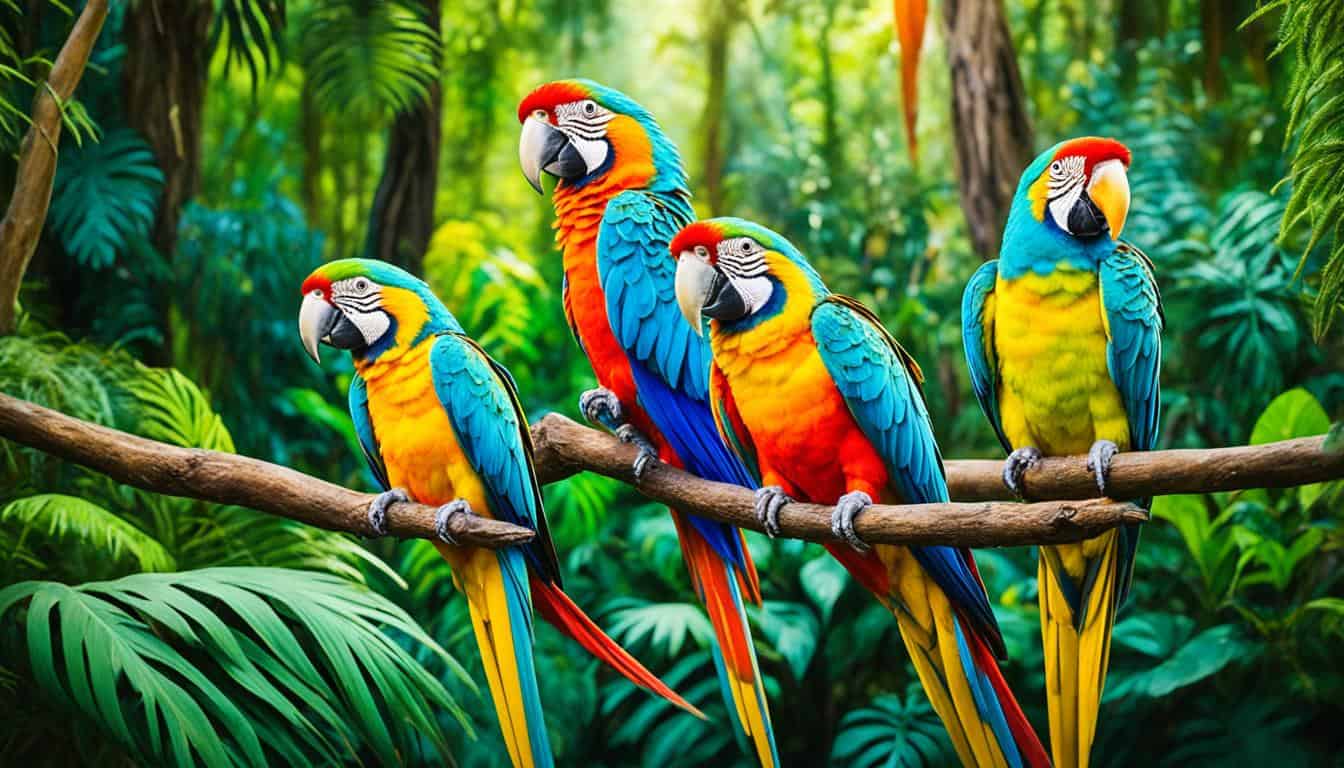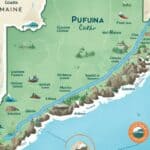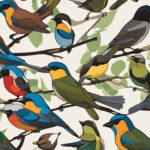Ever thought about native parrots in the United States? The Thick-billed Parrot used to live there but now only lives in Mexico. The Carolina Parakeet was another type, but it’s extinct, gone for almost a hundred years. Even though they’re not here now, their story is still an important part of America’s natural history.
The Historical Presence of Native Parrots in the USA
The USA once had the Carolina Parakeet and the Thick-billed Parrot flying freely. These parrots were key in the nation’s wild and cultural scene.
Carolina Parakeet: America’s Lost Native Parrot
The Carolina Parakeet stood out with its beautiful, unique colors. Sadly, it disappeared in the early 20th century. People cut down its forests and hunted it. In 1918, the last one, Incas, died at the Cincinnati Zoo. Losing the Carolina Parakeet was a big blow for the USA’s variety of life.
Thick-billed Parrot: The Last Surviving Native Parrot
The Thick-billed Parrot remains the last U.S. native parrot species to survive. Yet, it’s now only in Mexico. This parrot used to live in Arizona and New Mexico. But it moved further south because of people. Efforts to bring it back in the 1980s and 1990s didn’t work out. Even so, the Thick-billed Parrot is a symbol of historic USA bird species.
Are there any native parrots in the USA?
Understanding native parrots in the USA is key. “Native” means they’re from here, not brought in by people.
Understanding the Definition of “Native”
A native species lives in a place on its own, not because humans put it there. The Thick-billed Parrot was native to the USA but now only lives in Mexico. They used to live in places like Arizona and New Mexico.
Current Status of Native Parrots
There are no longer native parrot species living freely in the USA. The Thick-billed Parrot is a good example, gone from Arizona and New Mexico. It now only lives in Mexico. This change happened because of people hunting them, destroying where they lived, and trying but failing to put them back in the wild. People who love watching birds are worried about them. They try to save the ones that remain by studying and making their homes better.
Now, a lot of work is being done to help the Thick-billed Parrots where they live in Mexico. People and groups are doing their best to increase their numbers and keep them safe. Your help and knowing about them are very important. It helps in saving these special birds.
Thick-billed Parrot: The Lone Native Species
The Thick-billed Parrot is a special part of North America’s parrot world. With its bright colors and friendly ways, it stands out. Though it used to fly across the USA, it’s now mainly found in Mexico. Learning about its life, what keeps it safe, and what puts it in danger is key to its future.
Habitat and Behavior
In “sky islands” of high forests, the Thick-billed Parrot is truly unique. It loves socializing, from eating together to sleeping in groups. Their diet is mostly pine seeds. They also make homes in tree holes, showing how well they fit their home.
Conservation Status and Efforts
Sadly, they’re no longer in the USA because of people’s actions. Now, Mexico works hard to keep them safe. Organizations like Pronatura Noreste watch over them and make sure their homes are safe. Yet, they still face big risks, and it’s vital to do more to keep them around.
| Location | Conservation Initiatives | Partners Involved |
|---|---|---|
| Mexico | Nest Monitoring | Pronatura Noreste |
| High Mountain Forests | Protected Areas | Local NGOs |
Threats Faced by the Thick-billed Parrot
There are several dangers that threaten the Thick-billed Parrot’s future. The illegal pet trade is a major problem. Logs take away their homes, and changing climates make it hard for them to survive. We need urgent action to protect this amazing species.
Your understanding and support are crucial. Together, we can make a real difference for the Thick-billed Parrot and its home.
The Extinct Carolina Parakeet
The Carolina Parakeet once filled the skies across the U.S. Its bright colors and plentiful numbers made it stand out. From New York to the Gulf of Mexico, people recognized this bird at first glance.
Historical Range and Habitat
This parrot called the USA its home, living in a variety of places. From thick forests down south to the edges of rivers and swamps, it was everywhere. The far-reaching presence of the extinct Carolina Parakeet shows it could live in many different places.
Causes of Extinction
Many things led to the Carolina Parakeet’s extinction. Lost homes from farming and growing cities hurt their numbers. People also hunted them for their beautiful feathers. Plus, other birds moving in meant less places for them to nest. These pressures combined to push them towards disappearing. This history shows how actions by people can affect native parrots across the U.S.
The Carolina Parakeet’s decline is a poignant reminder of the consequences of unchecked industrial growth and environmental neglect.
Legacy and Lessons Learned
The loss of the Carolina Parakeet is a big warning for conservation. This American bird’s story reminds us to value and protect our environment. Stronger rules about hunting and saving forests can help. They guard against the Carolina Parakeet’s fate happening again to other birds.
Invasive and Feral Parrot Populations in the USA
Native parrots are not found in the United States. Instead, feral parrot populations have grown. These include Monk Parakeets, Red-crowned Parrots, and Yellow-chevroned Parakeets, which now nest in some states.
Originally pets or escapees, these feral parrots are now a subject of study. Their effect on local habitats is closely monitored. Knowing about these birds helps manage their impact on the environment and native birds.
Here is a table showing some major feral parrot populations in the USA:
| Species | State(s) Found | Common Characteristics |
|---|---|---|
| Monk Parakeet | New York, Illinois, Florida | Highly social, builds large communal nests |
| Red-crowned Parrot | Texas, California | Bright red forehead, often found in urban areas |
| Yellow-chevroned Parakeet | California, Florida | Distinctive yellow wing patches, adaptable diet |
Commonly Seen Parrot Species in the Wild
In the USA, some feral parrot species are seen more often. They thrive in cities and are a common sight. These birds have learned to live alongside people.
Monk Parakeet
The Monk Parakeet is widely spread across the USA. They make large stick nests together. You can find them in big cities like New York, Chicago, and some places in Florida.
Red-crowned Parrot
The Red-crowned Parrot is from northeastern Mexico. It has made its mark in Texas, where it looks at home. With its green body and red forehead, it shows how birds can adapt.
Yellow-chevroned Parakeet
The Yellow-chevroned Parakeet is another well-known parrot. They live in California and Florida, especially in parks and neighborhoods. Their yellow wing patches stand out, showing their ability to live in various places.
In the USA, these feral parrot species highlight the effects of pet trade. They show us how these colorful birds can adjust to new homes.
States with the Most Feral Parrot Sightings
In the United States, feral parrots are a key part of birdwatching. Florida, California, and Texas are known for many of these lovely birds.
Florida: A Feral Parrot Haven
Florida stands out for birdwatchers in the USA because of its many parrots. It’s home to types like the Monk Parakeet and Nanday Parakeet. They like Miami-Dade County’s warm weather and different areas. More than 35 types of parrots make Florida’s landscapes even more special.
California: Hotspots for Urban Parrots
California is another place where you’ll see feral parrots. With its cities and nice weather, it’s great for them. Birds like the Red-masked Parakeets in San Francisco and the Mitred Parakeets in Los Angeles have found homes in the city. They get food from urban areas and build their nests there.
Other Notable States
States not normally thought of, like Texas, also have feral parrots. The Red-crowned Parrots do well around the lower Rio Grande Valley. Even in big cities during migration, like Chicago and New York City, you might see Monk Parakeets. These sightings add to the fun of birdwatching in the US.
Why Some Parrot Species Thrive in Urban Environments
Some parrot species are not just surviving but thriving in our cities. Their success shows how well they’ve adapted to urban life. This adaptability is truly remarkable.
Adaptability and Diet
Feral parrots can live well in the city because of their flexible diets. They find food in many places, from tree fruits to what people put in bird feeders. This variety in what they eat helps them stay healthy, even in a changing city environment.
Nesting Habits
Parrots have smart nesting habits that help them in cities. The Monk Parakeet makes big nests where many of them can live. You can see these nests on top of poles and buildings. This type of nest helps them live together and use space efficiently in urban areas.
Human Impact
People have both positive and negative effects on feral parrots. Cities can be good places for them to live because of our structures. But, things like car accidents and pollution are big risks for them. Despite these challenges, their ability to adapt and their strong will help them survive in our cities.
The Role of Birdwatching in Tracking Parrot Populations
Birdwatching is vital in the USA for tracking parrot populations. It looks at both the native and non-native parrots. This helps us understand how their numbers change over time.

Platforms like eBird let regular people, not just scientists, add to our knowledge. They observe parrots and share what they see. This helps scientists understand where the parrots are and what they are doing.
States across the USA work on birdwatching with citizen scientists to watch parrots, finding out where they go and what they need.
Here is how some states do in tracking their parrots:
| State | Notable Parrot Species | Key Observations |
|---|---|---|
| Florida | Monk Parakeet, Red-crowned Parrot | High population density in urban areas |
| California | Yellow-chevroned Parakeet, Red-masked Parakeet | Diverse species adapted to city environments |
| Texas | Monk Parakeet, Red-crowned Parrot | Significant sightings in both rural and urban areas |
Enjoying birdwatching in the USA can deepen your love for nature. It also helps in meaningful ways to track parrot populations. By participating, you join a big effort to help birds. This supports important research and conservation. So, it’s a way to do your part for bird protection in the US.
Conservation Efforts and How You Can Help
Efforts to save parrot species mainly aim at saving their homes, funding research, and teaching the public. The American Bird Conservancy leads many of these efforts. This group works hard to protect places where parrots live, like the Thick-billed Parrot.
They make sure these birds have safe spaces and keep track of how many are left. This care helps the parrots keep living for those who come after us.
Everybody plays a big part in saving these birds. You can help by giving money or time to groups that protect bird homes. And by pushing for laws that help birds at all levels of government.
It’s also important to be good to pets that come from wild places. The pet trade harms wild parrots. By picking pets from safe places, you help save these birds. Being involved in saving parrots is part of keeping nature safe.
FAQ
Are there any native parrots in the USA?
The USA used to be home to parrots like the Carolina Parakeet and Thick-billed Parrot. Sadly, due to extinction and migration, none remain now. However, the Thick-billed Parrot can still be found in Mexico today.
What historical parrot species were native to the USA?
Two parrot species, the Carolina Parakeet and the Thick-billed Parrot, were native to the USA. The Carolina Parakeet is gone, though, extinct since the early 20th century. The Thick-billed Parrot is now only found in Mexico.
What led to the extinction of the Carolina Parakeet?
Sadly, deforestation and hunting led to the Carolina Parakeet’s extinction. It also faced challenges from introduced species battling for their nesting sites. This loss was a huge blow to biodiversity.
What is the current status of the Thick-billed Parrot?
Today, the Thick-billed Parrot is listed as Endangered and lives mainly in Mexico. This parrot faces threats from illegal pet trade, logging that destroys its home, and a changing climate.
Are there efforts to reintroduce the Thick-billed Parrot into the USA?
Efforts were made in the 1980s and 1990s to bring the Thick-billed Parrot back to the USA. Unfortunately, they weren’t successful. Now, the main goal is keeping these parrots safe in Mexico.
Which feral parrot species are commonly seen in the USA?
In the USA, you might spot Monk Parakeets, Red-crowned Parrots, and Yellow-chevroned Parakeets flying free. Originally pets, they escaped and now live in groups across several states, enjoying the freedom of the wild.
Where in the USA can you find the most feral parrot sightings?
The most sightings of feral parrots in the USA come from Florida, California, and Texas. These states’ climates and living spaces attract and support parrot colonies, making them ideal homes.
How do some parrot species adapt to urban environments?
Parrots are smart and can make cities their homes by eating a wide range of foods. They find places in urban settings to build nests and make the best of their environment.
What role does birdwatching play in tracking parrot populations?
Birdwatching is key to keeping an eye on parrot numbers, whether they’re wild or escaped. Tools like eBird let anyone help out by sharing sightings, which is important for science and helping parrots.
How can individuals contribute to parrot conservation efforts?
We can all pitch in for parrot conservation by helping groups like the American Bird Conservancy. Supporting laws that protect wildlife and owning pets responsibly are also powerful ways to make a difference.







